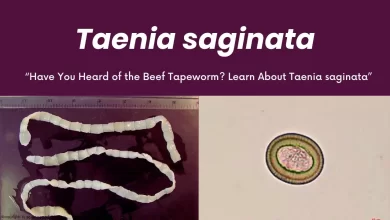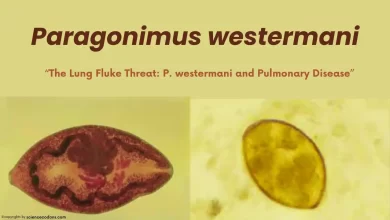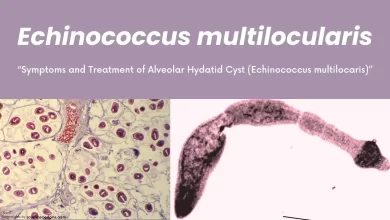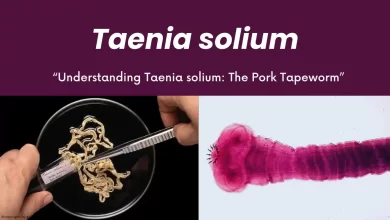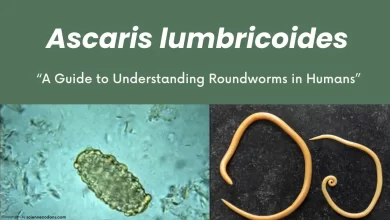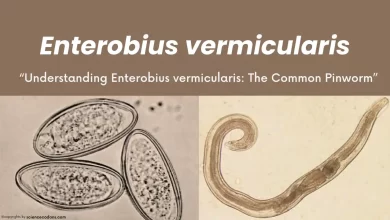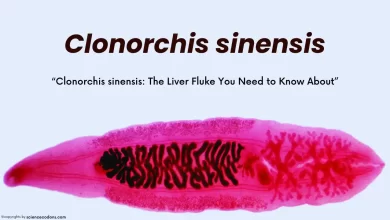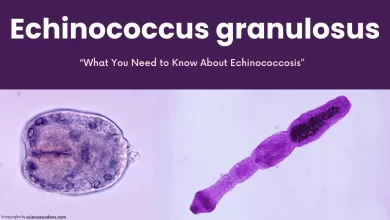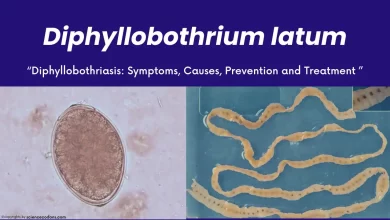Hymenolepis nana, commonly known as the dwarf tapeworm, is recognized as one of the most common cestodes (tapeworms) infecting humans, particularly children.
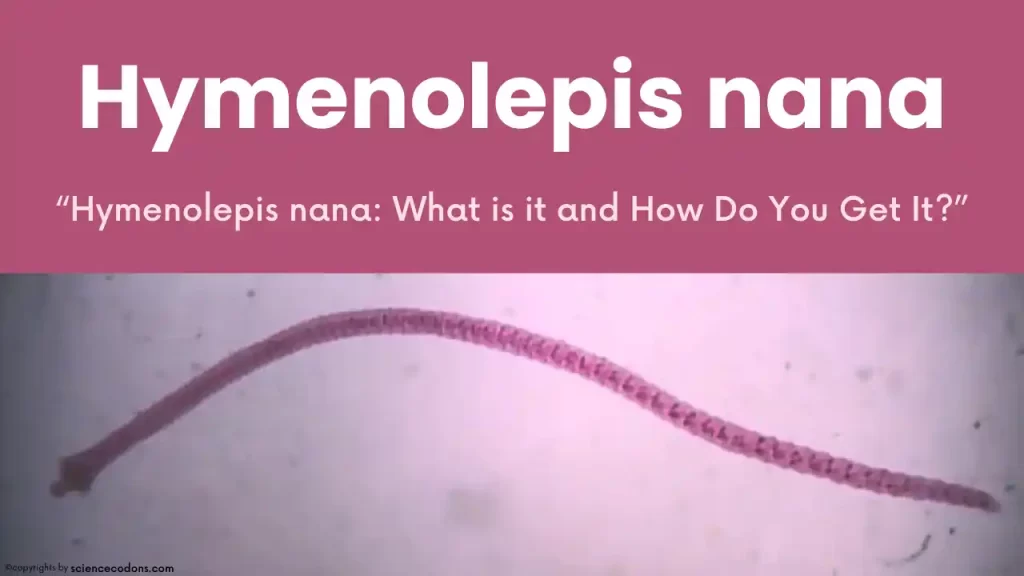
Hymenolepis nana, also known as the dwarf tapeworm, belongs to the Hymenolepididae family within the Cyclophyllidea order. This parasite is the most prevalent cestode infecting humans, causing either digestive symptoms in response to the parasite itself or allergic symptoms in response to the parasite’s secretions.
What is Hymenolepis nana?[Morphology & Characteristics]
Hymenolepis nana is the smallest and most common human cestode. Although Echinococcus granulosus and E. multilocularis are smaller, they are not human parasites and instead infect canines and carnivorous wildlife. It was first reported by Bilharz in 1851 and measures 2-4 millimeters.
H. nana has between 100-200 segments, typically wide, and a spherical scolex with 4 suckers, a rostellum, and a row of 20-30 hooks. It has 3 testes, a single bipartite ovary, and its final host is exclusively human. Due to its direct life cycle, it is the most common cestode.

The larval stage of Hymenolepis nana, known as a cysticercoid, forms inside the intestinal epithelial cells. Its eggs differ from those of Taenia in that they are double-walled but lack radial lines between the two walls. Instead, protrusions were created at the two poles, from which 4 to 8 polar filaments emerged. A six-hooked embryo or oncosphere is located between the two layers, and the size of the eggs is 37 by 47 microns.
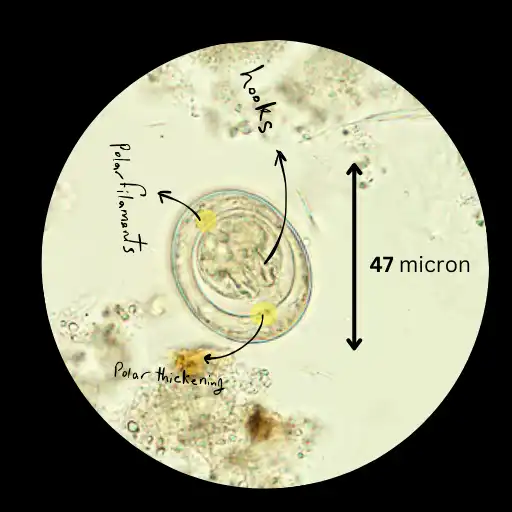
Lifecycle and Transmission of H. nana
H. nana is the only cestode with a direct and monoxenous life cycle, and its only host is human. Both the adult worm and its larvae live in the human digestive system.
Humans start to excrete eggs, usually mature ones. If the person eats these eggs again due to lack of hygiene, external autoinfection occurs. However, if a person is constipated and the eggs open inside the intestine, they can re-infect the person, causing internal autoinfection. After eating the eggs, the six-hooked embryo comes out and forms a cysticercoid inside the villi. Cysticercoids turn into adult worms within 10 to 15 days and start to excrete segments and mature double-walled eggs.
| Stage | Description |
|---|---|
| Egg | Passed in the stool of an infected host. |
| Intermediate Host | Various arthropods (beetles, fleas) ingest the eggs. |
| Cysticercoid Formation | Eggs develop into cysticercoids within the intermediate host. |
| Human or Rodent Infection | Cysticercoids can infect humans or rodents upon ingestion. |
| Adult Tapeworm | Develops in the small intestine. |
| Gravid Proglottids | Mature segments containing eggs are passed in the stool. |
| Internal Autoinfection | Hexacanth embryos penetrate the intestinal villus, continuing the cycle without external exposure. |
| Adult Worm Lifespan | Approximately 4 to 6 weeks, but internal autoinfection allows persistence for years. |
There is a species of H.nana called H.nana fraterna, or the mouse species, which has a very rare human infection. It is mostly found in mice and rodents infected by eating their feces and babies. The larval stage is in the feces’ body, and the mouse gets infected by eating it. The adult worm is in the mouse’s intestine.
Symptoms and Health Impact
Hymenolepis nana, due to its small size, usually doesn’t show any symptoms in light infections. However, in severe infections where the worm count is high, symptoms such as restlessness, irritability, eosinophilia (16%), digestive symptoms like abdominal pain and nausea, anal itching, and rarely bloody diarrhea or dysentery accompanied by mucus may occur.
Symptoms like headache, fever, and dizziness may also appear depending on the host’s sensitivity to the worm’s secretions. These secretions are antigenic, and the immune system responds to these antigens, causing symptoms similar to an allergic reaction.
| Symptom | Description |
|---|---|
| Toxemia | Generalized symptoms due to toxins produced by the tapeworm. |
| Anorexia | Loss of appetite. |
| Intestinal inflammation | Inflammation of the intestinal lining. |
| Nausea | Feeling of sickness or queasiness. |
| Diarrhea | Frequent, loose, or watery stools. |
| Abdominal pain | Crampy pain in the abdominal area. |
| Weakness | Generalized lack of strength or energy. |
Diagnosis and Treatment of H. Nana
Diagnosis
Hymenolepis nana is diagnosed through stool testing, where eggs, segments, and mucus in the stool are observed. For this purpose, a stool sample is prepared, and the slides are observed under a light microscope. Eosinophilia has been seen in 5 to 16 percent of infected children, which can be confirmed by checking a Complete Blood Count (CBC).
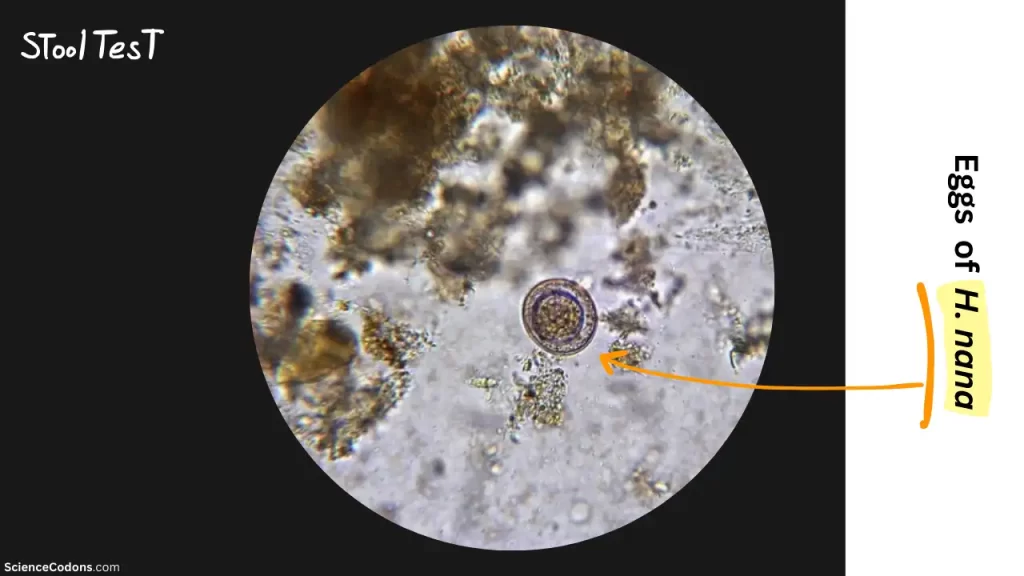
Treatment

For the treatment of Hymenolepis nana, Niclosamide or Yomesan can be used. The patient is given four chewable tablets of 500 milligrams (2 tablets in the morning and 1 to 2 hours later, two more tablets are taken). Praziquantel is given to the patient as a single dose of 25 milligrams per kilogram, with the next dose given 10 days later. Mirazid is used at a dose of 10 milligrams per kilogram for 9 to 10 days. Please note that each of these drugs has its specific indications for prescription and must be used under the supervision of a doctor. Self-medication should be avoided.
Prevention and Public Health Measures
Preventing H. nana infection largely depends on maintaining good personal hygiene and sanitation. This includes washing hands with soap and water after using the toilet and before handling food, ensuring that food and water sources are clean and safe from contamination.
Conclusion
Hymenolepis nana is a parasitic tapeworm that poses a significant health risk, particularly in regions with inadequate sanitation. Understanding its lifecycle, transmission, and prevention is essential for controlling its spread and safeguarding public health. With proper hygiene, sanitation, and treatment, the impact of this parasite can be significantly reduced.
Reference
- Hench, Juergen et al. “Hymenolepis nana: A case report of a perfect IBD camouflage warrior.” Medicine vol. 96,50 (2017): e9146. doi:10.1097/MD.0000000000009146
- Cabada, Miguel M et al. “Hymenolepis nana Impact Among Children in the Highlands of Cusco, Peru: An Emerging Neglected Parasite Infection.” The American journal of tropical medicine and hygiene vol. 95,5 (2016): 1031-1036. doi:10.4269/ajtmh.16-0237
- Book: Diagnostic Medical Parasitology by Lynne S. Garcia
- Parasitology: An Introductory Text by Robert F. Cox
